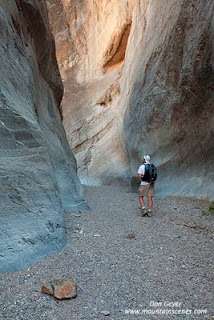 |
| Sliding rock at southern end of The Racetrack |
The Racetrack is probably the most intriguing feature in
Death Valley National Park, involving sliding rocks on the barren playa. You've surely seen the pictures. They are very recognizable as the rocks leave a long trail behind.
Located between the Cottonwood Mountains to the east and the Nelson Range to the west,
the Racetrack is exceptionally flat and level (only 1.5" height difference between its southern and northern end). It's dry for almost the entire the year. But when heavy rains do arrive, water rushes down these mountains onto the playa, forming a shallow lake. It's short-lived as the hot desert sun quickly evaporates the water, leaving a surface of soft, slick mud.
 |
| Sailing stones on north end of playa. |
The
sliding rocks, or "sailing stones", slowly move across the slick surface of the playa with the aid of strong winter winds, leaving a track behind them. This phenomenon has never been witnessed or filmed, likely because the remote playa is not approachable under such conditions.
These stones only move once every 2 to 3 years, and their tracks last 3 to 4 years. Stones with rough bottoms tend to leave straight tracks, while smooth-bottomed stones wander.
Interesting, huh? Most photographers think so!
There is a challenge to visiting this playa, however. It is very remote, accessed via a very rough 28 mile road. The Racetrack Road is best suited for high-clearance vehicles. Flat tires are a common occurrence. The road can be heavily washboarded, rattling suspensions, and must be driven slowly. I would budget at least 3 hours for this drive. Storms and flash floods can make the road undrivable.
 |
| Teakettle Junction. |
The Racetrack Road is an interesting and scenic drive. Flowers can line the early stretches of road in spring. At about 9 miles in, the road passes through a Joshua tree forest with many photographic opportunities. Legendary
Teakettle Junction is reached 10 miles further. Past Teakettle Junction was the roughest stretch of road during my visit - 9 miles of extremely washboarded road to the Racetrack. These poor conditions continue to Homestead Dry Camp, in case that is your destination.
Excellent photography can be had in both morning and evening at the Racetrack. Morning is considered the better light, but I achieved my best images while scouting the evening before. The southern end of the playa tends to have the most rocks, while the north end sports The Grandstand, which makes a fun compositional backdrop if rocks are present. There were no rocks near The Grandstand during my visit, to the shock of several photographers who had just visited the year prior.
 |
| Sliding rocks on the Racetrack. |
Morning light happens fast here, so definitely spend time scouting the playa the day before for the best rocks and tracks. You will also find that the rocks come in all shapes and sizes, and sometimes can be photographed in pairs.
Enjoy your visit and travel safely!
This is my last installment on photographing in Death Valley National Park. I hope you've enjoyed my recommendations and tips, and that I have inspired you to visit this wonderful place yourself. If you would like to see more images, please check out my Death Valley gallery.
Thanks for reading. And as always, feel free to send me a note with any questions you may have that I have not answered here.








